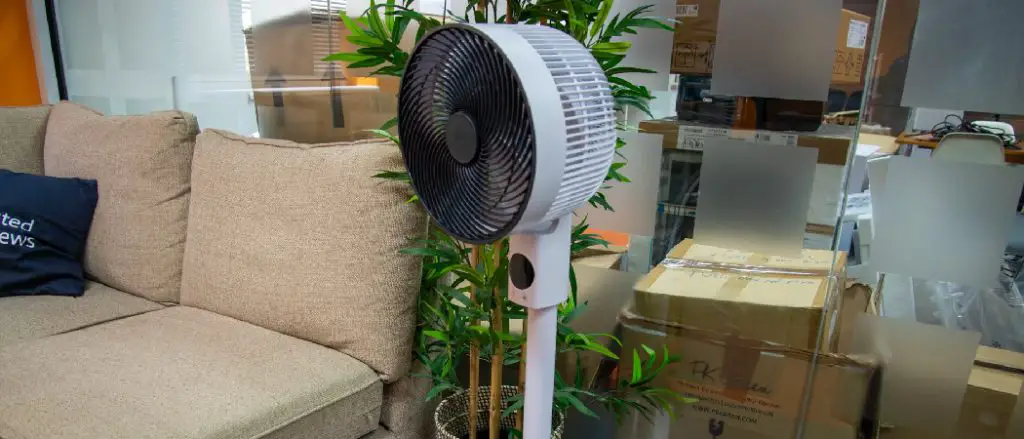To fix a loud bathroom fan, you need to clean or replace the fan blades and tighten any loose screws. Additionally, you can try lubricating the motor and checking for any obstructions in the fan housing or ductwork.
Addressing these issues will help reduce the noise and ensure proper functioning of the fan. When a bathroom fan becomes loud, it can be an annoying and disruptive problem. Not only does it affect the peace and quiet in your home, but it can also indicate a malfunction or damage that needs attention.
We will provide you with simple and effective solutions to fix a loud bathroom fan, so you can enjoy a calm and well-ventilated bathroom environment.

Importance Of Addressing The Noise Issue
Bathroom fans are essential for maintaining air quality and preventing mold growth. However, when these fans become loud, they can be a source of disturbance and inconvenience.
Prevent Disruption
Loud bathroom fans can disrupt your daily routine and create an unpleasant environment. Addressing the noise issue promptly can help maintain a peaceful atmosphere in your home.
Disturbance
A loud bathroom fan can disrupt your relaxation time and disturb household members. By fixing the noise issue, you can ensure a quiet and comfortable bathroom experience for everyone.
Identifying The Source Of The Noise
Is your bathroom fan making an annoying racket? Don’t worry, you’re not alone. Noisy bathroom fans can be a common issue, but the good news is that most problems can be easily fixed. The first step in resolving the issue is identifying the source of the noise. By pinpointing the cause, you’ll be able to address the problem effectively and restore tranquility to your bathroom.
Fan Blades
One possible source of the noise could be the fan blades. Over time, dust, dirt, and debris can accumulate on the blades, causing them to become unbalanced and produce a loud noise. To check if this is the issue, turn off the fan and inspect the blades. If you notice a buildup of dirt or any objects stuck in the blades, it’s time for a cleaning. Using a soft cloth or brush, gently remove the dirt, ensuring not to bend the blades. Once you’ve cleaned the blades, turn the fan back on to see if the noise has diminished. Often, this simple maintenance step can solve the problem.
Motor Issues
Anothther potential source of noise is motor issues. The motor, responsible for powering the fan, can become worn or damaged over time. If you suspect motor issues, start by turning off the power to the fan at the circuit breaker. Then, remove the fan cover and locate the motor. Inspect the motor for any visible signs of damage, such as loose connections or frayed wires. If you identify any issues, it’s best to call a professional technician to repair or replace the motor. Attempting to fix electrical problems yourself can be dangerous if you’re not experienced.
If there are no visible motor issues, you can try lubricating the fan motor to reduce noise. Apply a few drops of lubricating oil to the motor’s bearings, following the manufacturer’s instructions. This can help reduce friction and noise caused by a dry motor. However, be cautious not to over-lubricate, as this can lead to more problems.
By identifying the source of the noise, whether it’s from the fan blades or the motor, you can take the necessary steps to fix the issue. Remember, regular cleaning and maintenance can prevent future problems and extend the lifespan of your bathroom fan. Happy fixing!
Simple Diy Solutions
In this section, we will explore some simple DIY solutions for fixing a loud bathroom fan. These solutions can help you address the issue without the need for professional assistance, saving you time and money. Let’s dive into the simple fixes that you can implement to reduce the noise coming from your bathroom fan.
Cleaning The Fan Blades
If your bathroom fan is producing loud noises, it may be due to the accumulation of dust and dirt on the fan blades. To clean the fan blades, first, switch off the power to the fan. Then, use a soft brush or vacuum cleaner to gently remove the dirt and debris from the blades. After cleaning, wipe the blades with a damp cloth to ensure all residue is removed. This simple maintenance task can significantly reduce the noise produced by the fan, allowing it to operate more quietly.
Tightening Loose Screws
Loud noises from a bathroom fan can sometimes be attributed to loose screws or mounting hardware. To address this issue, use a screwdriver to tighten any loose screws or fittings that secure the fan in place. Inspect the entire unit to ensure all components are securely fastened. By tightening any loose elements, you can stabilize the fan and minimize the rattling or vibrating sounds that may be occurring.

Upgrading Components
If you have a loud bathroom fan that is disturbing your peaceful retreat, upgrading its components is a great solution. By replacing the motor or installing a noise-reducing fan, you can enjoy a quieter and more relaxing bathroom experience. In this article, we will explore these two options in detail.
Replacing The Motor
If your bathroom fan is generating excessive noise, it might be due to a worn-out or faulty motor. Replacing the motor can drastically reduce the noise level and restore your fan to its optimal performance. Here’s how you can replace the motor of your bathroom fan:
- Turn off the power to the fan by switching off the appropriate circuit breaker in your electrical panel.
- Remove the fan cover or grille to access the fan assembly.
- Disconnect the wiring from the motor by carefully removing the wire connectors.
- Unscrew and remove the motor from the fan assembly.
- Install the new motor by aligning it with the screw holes and securely fastening it.
- Reconnect the wiring to the new motor by attaching the wire connectors.
- Replace the fan cover or grille and turn on the power to test the new motor.
By following these steps, you can easily replace the motor of your bathroom fan and enjoy a quieter environment.
Installing A Noise-reducing Fan
If replacing the motor doesn’t provide the desired noise reduction, installing a noise-reducing fan is an excellent alternative. These fans are specifically designed to minimize noise while maintaining proper ventilation. Consider the following factors when choosing a noise-reducing fan:
| Factor | Consideration |
|---|---|
| Noise Level | Look for fans with a low sones rating, as lower sones indicate quieter operation. |
| Airflow Capacity | Ensure that the fan provides sufficient airflow to effectively ventilate your bathroom. |
| Energy Efficiency | Choose a fan that is energy-efficient to save on electricity costs in the long run. |
Once you have selected the appropriate noise-reducing fan, follow these general installation steps:
- Turn off the power to the fan by switching off the appropriate circuit breaker in your electrical panel.
- Remove the existing fan assembly by unscrewing it and disconnecting the wiring.
- Install the new noise-reducing fan by following the manufacturer’s instructions.
- Ensure the fan is securely fastened and the wiring is properly connected.
- Reattach the fan cover or grille and turn on the power to test the new fan.
With the installation of a noise-reducing fan, you can enjoy a peaceful and tranquil bathroom environment without the annoying fan noise.
Regular Maintenance Tips
Keep your bathroom fan in top condition by following these regular maintenance tips to fix any noisy fan issues. Clean the fan blades and housing, tighten loose screws or parts, and ensure proper ventilation to avoid disrupting the peace in your bathroom.
Regular maintenance tips are essential for keeping your bathroom fan running smoothly. By following these simple maintenance tasks, you can ensure your fan remains quiet and efficient.
Cleaning regularly can prevent the buildup of dust and debris, which can cause the fan to make loud noises. Use a soft brush or cloth to remove any dirt that has accumulated on the fan blades or housing.
Cleaning Regularly
An unobstructed fan is a quiet fan. Regularly check and clean the fan vents to ensure proper airflow and reduce noise levels.
Lubricating moving parts can help reduce friction and noise caused by wear and tear. Use a silicone-based lubricant to grease the fan motor and bearings.
Lubricating Moving Parts
Apply lubricant sparingly to avoid excess buildup, which can attract more dust and grime. Regular lubrication can extend the life of your bathroom fan and keep it running quietly.
Following these maintenance tips can help you fix a loud bathroom fan and ensure it operates efficiently for years to come.
:max_bytes(150000):strip_icc()/quietest-bathroom-exhaust-fans-1821003-hero-60eb64b845e04652b370ad8aed9ec9ec.jpg)
Consulting A Professional
When dealing with a loud bathroom fan, consulting a professional is the best course of action. An experienced technician can accurately diagnose and fix the issue, ensuring proper function and peace of mind. Hiring a professional can save time and effort, while avoiding potential safety hazards or damage to the fan.
When Diy Fixes Fail
Attempting DIY fixes can sometimes fall short in resolving the issue with a loud bathroom fan.
When efforts go unrewarded, it’s time to turn to the expertise of a professional.
A professional will have the knowledge and tools to accurately diagnose and repair the fan.
Seeking Expert Advice
Expert advice becomes essential when dealing with persistent bathroom fan noise issues.
– Professionals can provide tailored solutions based on the fan’s specific problem.
– Consultation with a professional ensures the noise problem is addressed effectively.
Investing in professional assistance can save time and prevent further damage.
Frequently Asked Questions For How To Fix A Loud Bathroom Fan
Why Is My Bathroom Exhaust Fan So Loud?
The bathroom exhaust fan may be loud due to a faulty motor or worn-out parts. It can also be caused by dust accumulation or improper installation. Maintaining and cleaning the fan regularly can help reduce noise.
How Can I Make My Bathroom Fan Quieter?
To make your bathroom fan quieter, clean the fan blades, ensure proper installation, and use a vibration isolation mounting.
How Do I Reduce The Noise Of My Exhaust Fan?
To reduce exhaust fan noise, check for loose parts, clean the fan blades, and ensure proper installation. Consider using a noise-reducing fan, adding a muffler, or installing soundproofing material.
What Happens If Bathroom Fan Is Too Powerful?
An overly powerful bathroom fan may create excessive noise and lead to decreased efficiency. The excessive power can also cause negative air pressure in the room, which can lead to potential structural damage and increased energy consumption. Adjusting the fan or installing a variable speed control can help mitigate these issues.
Conclusion
Fixing a loud bathroom fan can greatly improve the tranquility of your space. By following the steps outlined in this guide, such as cleaning the fan blades and lubricating the motor, you can easily address the root causes of the noise.
Remember to regularly maintain your bathroom fan to prevent future issues. Enjoy a peaceful and quiet bathroom experience without the annoyance of a loud fan.

